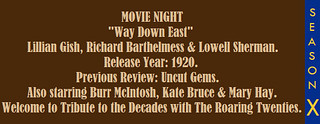
Review #1317: Way Down East.
Cast:
Lillian Gish (Anna Moore), Richard Barthelmess (David Bartlett), Lowell Sherman (Lennox Sanderson), Burr McIntosh (Squire Bartlett), Kate Bruce (Mother Bartlett), Mary Hay (Kate, Squire's niece), Creighton Hale (The professor), Emily Fitzroy (Maria Poole, landlady), Porter Strong (Seth Holcomb), Edgar Nelson (Hi Holler), and Mrs. Morgan Belmont (Diana Tremont) Directed by D. W. Griffith (#415 - America and #695 - Broken Blossoms)
Review:
Welcome to Movie Night: Tribute to the Decades. While Movie Night always tries to review films from every sort of decade, inevitably the show is a bit slow to cover certain decades in more depth (the 1930s for example have just 45 reviews, with the last review being from December 2017). Given that Movie Night is celebrating ten years in 2020, why not do theme kind of year? As such, each month will have at least four reviews that cover a certain decade, with this month being for the 1920s (the third least-covered decade with 65). The idea is to pick films that are either repersentative of the decade or something worthwhile in some sort of way. Certain months will be preceded by announcements over what is to be covered, but I do hope that you folks enjoy.
The 1920s were a blossoming time for film, particularly when it came to making features. Hollywood was now the center of where films would be made, fit for a decade wracked with extravagance and glamour. There had been feature films released in the previous decade that stood out as successes for features, such as Traffic in Souls (1913, one of the earliest kinds of narrative films), Cabiria (1914, an Italian epic silent release), The Birth of a Nation (1915, a controversial landmark from Griffith that proved a huge commercial success), Intolerance (1916, Griffith's further epic with four parallel storylines, and Cleopatra (1917, lost but known for its lavish sets). It cannot be denied, however, that the 1920s would be the decade that feature films came into further prominence (while the two-reeler kind of films lingered before shrinking further in later decades). While the decade found itself with struggle of evolving from silent to sound, most of the prominent films of this decade would come from silents like the one seen here. It is an adaptation of the 1898 play of the same name by Charlotte Blair Parker. The play proved an eventual hit, with Phoebe Davies (wife of the person who revived the show after initial release, which she starred in) going on to play the lead role for over 4,000 performances. It had been adapted twice before for film, and a further adaptation followed in 1935 that featured Henry Fonda. Anyone familiar with Griffith films will appreciate seeing Gish and Barthelmess together again, particularly for a film that runs at 145 minutes (not surprising given Griffith's collection of work that I mentioned and what would come later, such as the 150-minute Orphans of the Storm, also featuring Gish). It definitely has the feeling of a play at times, although Griffith is certainly talented enough to make this romantic drama engaging enough that it makes the experience worth viewing through the lens of a century since its release.
Gish carries the film as well as she does because of the expressions she can pull when the moment is needed. The concept of an innocent lured into seedy trappings is a familiar one to draw upon, and Gish lives up to someone that we can relate to, one that we can care about whenever dealing with a "marriage" proposal or when with her newborn without a name. Barthelmess proves just as capable, a soulful kind of presence that led to him having a following among women for the decade. Sherman pulls the right kind of smarminess through the eyes that makes for a worthy counterpart for the feature. The rest of the cast do their part just fine, whether if they are a family patriarch or bumbling comedy relief. The film is noted for its climatic sequence with ice floes down a river towards a waterfall as a snowstorm raged on. The ice sequence was filmed in White River Junction, Vermont, with a short waterfall being used. Ice needed to be sawed or dynamited before filming, with the crew making a small fire near the camera to keep the oil from freezing. The leads had to perform their own stunts, with Gish having her hair and hand trail in the water at one point (which led to impairment in her right hand for the rest of her life); Griffith had frostbite on one side of his face at one point. It certainly is a spectacular sequence, worthy of being remembered as a hallmark for a film that works out fine in entertainment for the time in holding up with its convictions through a director in his prime in Griffith. It might seem like old-fashioned melodrama, but Griffith managed to elevate it to something that still feels like timeless entertainment that endures to this very day, worthy for the curious at heart for cinema.
Overall, I give it 8 out of 10 stars.

No comments:
Post a Comment